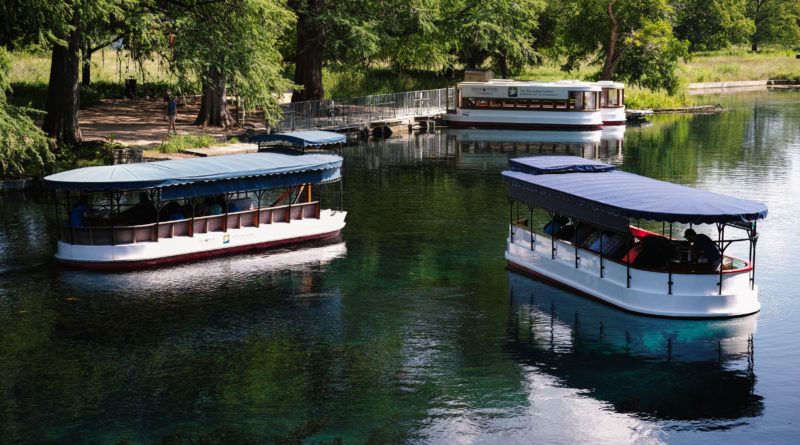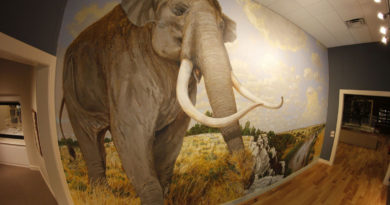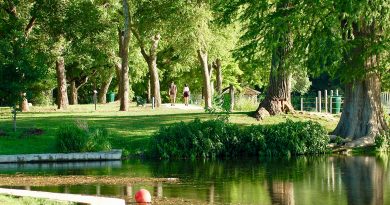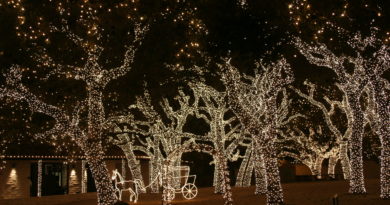A crystalline San Marcos River reveals a glimpse of the past
Story by SALLY GRACE HOLTGRIEVE
Contributed photos
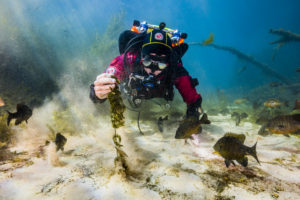
an eye on any invasive flora that grows on the bottom of the river. Photo by Jennifer Idol.
The Meadows Center for Water and the Environment, located in San Marcos, is full of natural discoveries ideal for a fall day trip. Formerly the amusement park Aquarena Springs, the site is now owned by Texas State University and dedicated to water research and conservation.
Begin your day with a tour of Spring Lake via a glass bottom boat for an overview of local ecology and history. The boat tours began in the 1940s, and though the boats have been refurbished over the years, they maintain their original wood and glass. Visitors sit on benches surrounding the glass floor of the boat while a guide provides commentary on surrounding sites. Spring Lake is so clear that visitors can see clearly to the bottom — 30 feet in some areas. The boat passes over a high pressure spring first.
“The water coming out of it can be compared to a fire hydrant with the top off,” said Tour Guide Christopher Crain, pointing out the adjacent strip of bare sand due to the constant blast of water.
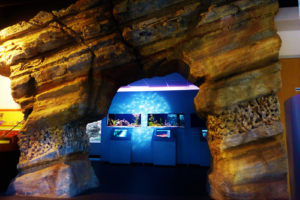
Originally from Beaumont, Crain said he’d never seen water with more than three feet of visibility until he came to San Marcos for the first time. He walked up to the San Marcos River, which is fed by Spring Lake, took one look at it and said, “I have to go to school here.” Crain is studying geography at Texas State University and enjoys teaching people about the unique habitat at The Meadows Center.
“My grandfather was actually a boat driver here in the 1960s,” Crain shared as he steered his glass bottom boat farther onto the lake. “My grandmother was a bookkeeper at the Spring Lake Park Hotel here. My grandpa tells stories about working on the boats back in the day, it’s cool that they are the same boats.”
About 5,300 species of turtles live in Spring Lake, Crain said. “That’s one of the most dense populations in North America.”
It’s easy to lose track of how many turtles you can spot from the boat — they pile onto logs poking out of the lake and line the bank. Species include Texas river cooters, red-eared sliders, musk turtles, softshell turtles and the common snapping turtle.
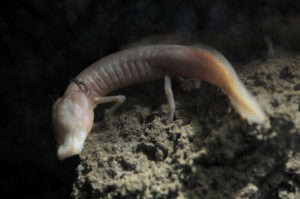
Crain pointed out where a submarine theater existed from 1946 to 1994. Visitors could go into the submerged submarine, eat lunch and look out the windows at the lake and spot more than just the native turtles and fish. The amusement park hired people to dress up as mermaids and swim around the submarine. “Ralph the swimming pig” was also a crowd favorite. The piglet was trained to swim using a baby bottle and would paddle around the lake.
There were actually multiple Ralphs, Crain said, so that a steady rotation of pig performances could be kept without exhausting any of the animals.
Pointing at a cluster of low pressure springs beneath the boat, Crain said they called that spot Cream of Wheat, “because it looks like boiling oatmeal. Those are more like a water faucet that’s been left on,” he said of the intensity. “There are tons of those throughout the lake, bubbling up in the sand.”
The area wasn’t always a lake. It used to be a stretch of the San Marcos River, until a dam was built to power a nearby grist mill in 1849 and the lake was formed.
An underwater archaeological dig was conducted in 1977, Crain said after pointing out a large pipe in the lake.
“They would scuba dive down and dig,” he explained. “They used the pipe to pull up water whenever it would get murky so they could still see.”
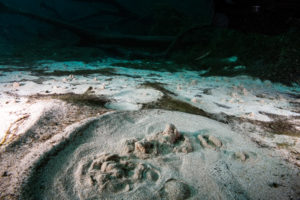
Secrets from the river
The dig produced about 100 thousand artifacts dating to more than 10,000 years ago, Crain said. Examples include a mammoth tooth and Clovis spearhead. The purpose of the dig was to create a timeline to see when people lived in the area and when they didn’t.
“They found there were no breaks at all, proving people have always lived here since they started living on this continent,” Crain said. “The natural spring would have been here all that time, providing clean drinking water and ensuring lots of wildlife in the area.”
Other fun tidbits include the fact the movie Piranha was made at Spring Lake in 1978 because the clear water made filming easy, and that the Balcones Fault runs through the middle of the lake.
Look to one side of the water and notice the land is extremely flat, Crain said from the middle of the lake. If you look to the other side, you’ll see the opposite — the land begins climbing vertically right out of the water. That’s because the Balcones Fault line divides the lake, marking Blackland Prairie on one side and the Texas Hill Country on the other. It’s fascinating to observe the obvious differences from the neutral point in the center of the lake.
Can’t get enough of the pristine water after your glass bottom boat tour? The Meadows Center partners with REI to offer kayak and stand up paddle board tours that can be booked in advance.
Next, stretch your legs with a walk around the Wetlands Boardwalk. The floating trail wraps through a wetland habitat thick with unique vegetation and of course, more turtles. Floods in 2015 caused the area to be inaccessible for a couple years, Communications Specialist Anna Huff said. It reopened to the public this January.
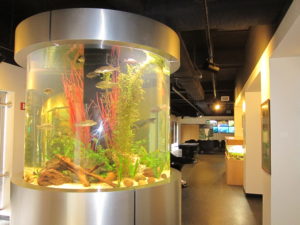
Educational entertainment
There is no food for purchase at The Meadows Center, but there are plenty of picnic tables if you want to pack a lunch or snacks. Visitors can also relax on the rooftop of the old hotel, which overlooks Spring Lake and the river beyond.
Built in 1929, the former hotel now houses offices on one side and the Discovery Center on the other. The conference room on the office side maintains the original hotel floors and facilities can be rented for parties and events.
The nonprofit Meadows Center began in 1994 when the University bought the site, Huff said of what goes on in the office portion of the building. The organization is dedicated to research, education, service and leadership.
“We have some specialized, highly knowledgeable staff members that are experts in environmental flows and watershed services,” Huff said. “We work with communities and partners across Texas to help find sustainable water solutions for a variety of issues.”
The service component is achieved through the Center’s citizen science team, also known as the Texas stream team.
About 8,000 people have been trained through the program. Once a month, each member will select a body of water and monitor the quality. All of the data is given to the Meadows Center and put into a database that is accessible to the public and the government. The project helps prevent problems such as E. coli, and staff members travel across the state conducting the trainings.
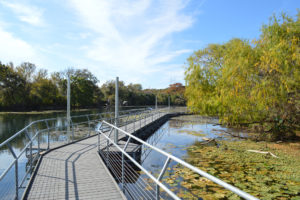
The Discovery Center is open to the public and houses large aquariums and exhibits to offer further insight and close up views of the wildlife in Spring Lake. Visitors can see the endangered Texas blind salamander and the San Marcos salamander along with various fish species and even more turtles.
An augmented reality sandbox invites the curious to create their own topographical map, and a nearby, new exhibit documents artifacts found on site — those from the underwater dig and newer pieces. It includes everything from bear and bison teeth to a variety of arrowheads.
As Huff said, The Meadows Center offers engaging information and experiences pertaining to nature, history, archeology, geology and more. It’s impossible to decide what aspect is the most interesting and best to just dive into it all.
If you go
201 San Marcos Springs Drive, San Marcos
• Take Interstate 35 S to exit 206.
• Continue on the I-35 frontage road and take a slight right onto Aquarena Springs Drive.
• Turn Left at Post Road.
• Turn right onto W Laurel Street/San Marcos Springs Drive.
• The destination will be on the left.

